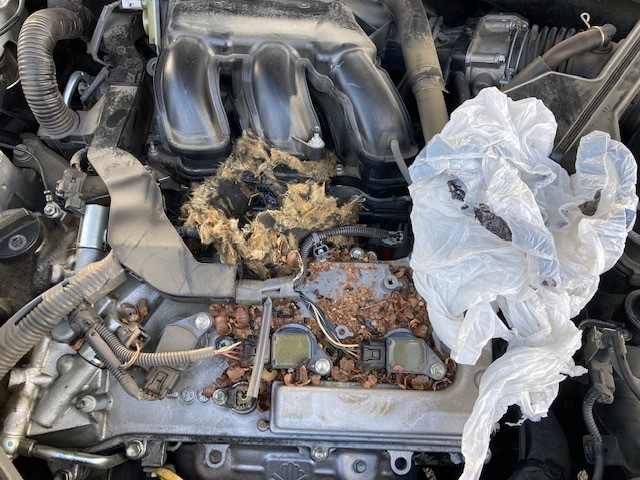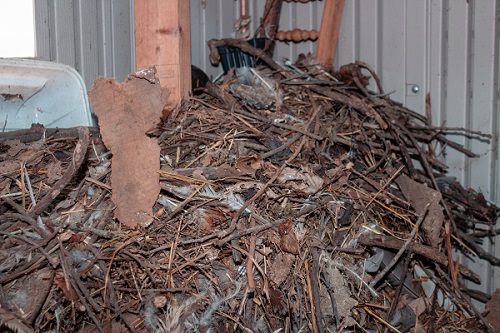A rat’s nest is a messy collection of materials woven together in a ball. Typically, they are about four to six inches in diameter. Rats create soft nests to sleep and to give birth to pups. Rats use a wide range of items to build a nest, mostly whatever is available to them in the area, such as cloth, paper shreds, insulation, twigs, vegetation, and more.
You can find a rat nest in your attic, under your house, inside the walls, or outside.
Rat Nesting Behavior
Nest-building is an important behavior for rats to ensure their survival, comfort, and overall well-being. Nests provide shelter from predators, harsh weather conditions, and reproduction. Female rats build nests to provide a warm and secure environment to give birth and raise their offspring. Nests help to keep the baby rats warm and protected.
Depending on their species, rats may have different nesting behaviors. Roof rats build nests up high and will not hesitate to build a nest in your attic or vents. Norway rats build nests closer to the ground, typically burrowing underground near the edges of your home. They may also enter your basement and crawlspaces.
Where Do Rats Usually Nest?
Rats are creatures of opportunity and will build nests wherever they see a spot that can offer warmth and access to food, water, and materials. You may find a rat living in your attic, building nests using insulation, and other items in storage or lying around. Some rats build nests in the ductwork, making using your heating and air conditioning unit hazardous.
Rats prefer dark and secluded locations to build nests.
Rat nests inside
- Ceilings
- Walls
- Eaves
- Under appliances
- Crawlspaces
- Basements
Rat nests outside
- Under the hood of your vehicle
- Piles of debris, wood, rocks, and vegetation
- Under porches and decks
- Burrows may run under your home, structures, or driveways

What Does a Rat's Nest Look Like?
If you were to take a bunch of different materials and wad them into a ball, that is what a rat’s nest looks like. They build nests using readily available items they find inside or outside your home. Typically, rat nests are soft and filled with carpet or clothing fibers, insulation, and paper. However, they also use steel wool, wires, plastic, and wood pieces. Whatever they can chew may become part of a nest.
Signs that you likely have a rat’s nest in your home include seeing or smelling rat droppings and urine, which line the trails they travel to get food and then back to their nest. You may also see rat footprints, greasy smudge marks, or damage from their chewing and gnawing. Additionally, listen for noises in your walls, like chirping or scratching.
- Fibers
- Fabrics
- Paper
- Styrofoam
- Wood shavings
- Cardboard
- Plastic pieces
- Leaves
- Twigs

How to Get Rid of Rat's Nest
Multiple rats live in a nest. When you find a nest in your home, avoid any instincts to pick it up and throw it outside. Doing so poses several risks, like encountering aggressive rats that may bite or scratch you to protect their nest. Rats carry diseases like leptospirosis, hantavirus, and salmonellosis. They contaminate nesting materials with feces and urine, one way they transmit diseases.
It’s essential to understand how to destroy a rat’s nest. It must be done in steps, starting with proper rat control. Also, to use the proper protective equipment.
Rats Nest vs Rat Burrows
What does a rat’s nest look like? They are balls of debris you may find in dark, vacant spots inside your home. If the nests are found in high locations, they likely belong to a roof rat. If nests are in your basement or crawlspaces, a Norway rat is the likely culprit.
Outdoors, Norway rats burrow underground. Burrows are small holes in the ground usually found along the home’s edges, under vegetation, shrubs, and bushes. Looking into the burrow, you will see it looks like a tunnel that is two to four inches wide and 18 inches deep. Some rats burrow multiple tunnels and create a den-like area connecting them all.
Norway rats can climb into your attic where they can burrow through your insulation. If you find tiny holes throughout your insulation, you might have a Norway rat infestation.
Rat Nest vs Mouse Nest
Rat and house mouse nests have a few differences. House mice like to be close to their food since they feed up to 20 times daily. They prefer to nest within 30 feet of their food source. Mice prefer to nest in warm areas, particularly under ovens, dryers, heaters, and ductwork. House mouse nests are smaller than a rat’s nest and are most often made of soft materials.
Rats will incorporate hard and soft materials in their nests. Rats tend to nest in hard-to-reach areas, whereas house mice will nest in areas where they are more exposed. Rat nests appear neater and more orderly than mice nests.
What to Do if You Have a Rats Nest at Home
If you find a rat nest in your house, there are things you must do before trying to remove a nest. First, ensure you have the proper safety equipment, including gloves and respirators. You must also identify the type of rat nesting to purchase the correct trap and bait. Once all the rats are removed, you can begin removing the nest.
The safest and easiest way to get rid of rats and rat nests is to hire a wildlife removal professional like the ones at Critter Control. Not only do they have the equipment, but they also have the knowledge to get the job done quickly and efficiently. Professionals also know how to prevent future rat infestations.
Let Trutech In to Get Rats Out
Trutech Wildlife experts use exclusion methods to prevent rats from nesting in your home or outdoors. Exclusion examples include filling in all burrows, decluttering your yard, and removing outside food sources. Inside, they can apply sanitization to areas where rats live and were active and permanently seal all holes and cracks where rats entered your home. They can install wire mesh to cover vent openings, chimney caps, and proper food storage.
Most importantly, professional rat removal companies identify hazards created by rats, such as gnawed wires, structural beams, missing insulation, and clogged ducts. Keeping you and your family safe is their goal.


